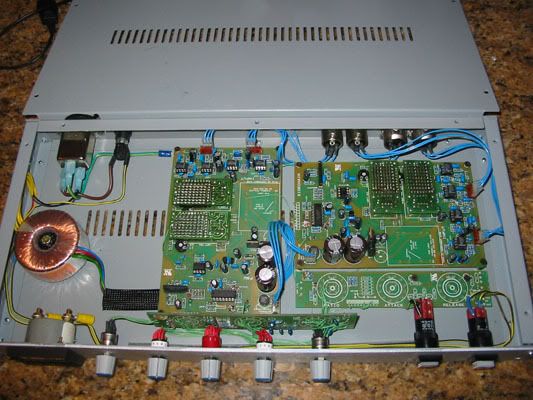SSLtech
Well-known member
So here's my version of the SSL buss compressor... looks pretty normal from the front:

But inside there's a little more than you'd expect...

EDIT: See this post on page 6 for full, condensed build instructions]
Basically it's more like the console buss compressor in one significant way. Jakob's version uses a summed-mono signal which is fed to a single sidechain VCA. phase, polarity and balance affect the detector output. In the console version, two sidechain VCAs feed two detectors, and the higher output is used. Balance, polarity and phase differences are ignored.
This is not to say that Jakob's version is not as good: -it's just different. Jakob himself says that he prefers the sound of his version, but I wanted something a little truer to the original.
Since building two detectors and sidechains meant using two boards; I decided to go one step further. The VCAs I used are the 202XT's, which are each composed of 8 x SIL VCAs for noise reasons. Since they are all used in the same pole, I built the second channel in each and polarity-flipped the signal through it, re-inverting at the end, to re-sum back in the same polarity. (You have to remove one sidechan-summing resistor to prevent the signal nulling...)
The signal thus passes through the VCAs in opposite polarity, and some of the residual VCA distortion is thus canceled. -This is how the SSL 9000 J and K series console center section buss compressor does it: the "Superanalogue" version... except that they do it with half as many VCAs in each pole, since it's getting a little expensive by that point!
In addition, the output summing also increases the output drive capability, and lowers the source impedance... this thing can run full output into about 200Ω without complaining even slightly!
It's built, it's powered up, it's working and the preliminary tests show that it's dead quiet. It's also showing less distortion than my home gear can measure: I'll have to get it reound do Scenaria's and run the Audio Precision on it to get any meaningful numbers!
So here it is. Front panel will eventually be printed with the laser printer/3MSuper77 method, but fo now I'm just glad it's finished!
This is a highly do-able version, there are minimal adaptations needed to two boards to make it work, and a 2-pole ration switch is the big part difference. I'm putting it in my new rack, pictures to follow soon.
Keith :guinness:

But inside there's a little more than you'd expect...

EDIT: See this post on page 6 for full, condensed build instructions]
Basically it's more like the console buss compressor in one significant way. Jakob's version uses a summed-mono signal which is fed to a single sidechain VCA. phase, polarity and balance affect the detector output. In the console version, two sidechain VCAs feed two detectors, and the higher output is used. Balance, polarity and phase differences are ignored.
This is not to say that Jakob's version is not as good: -it's just different. Jakob himself says that he prefers the sound of his version, but I wanted something a little truer to the original.
Since building two detectors and sidechains meant using two boards; I decided to go one step further. The VCAs I used are the 202XT's, which are each composed of 8 x SIL VCAs for noise reasons. Since they are all used in the same pole, I built the second channel in each and polarity-flipped the signal through it, re-inverting at the end, to re-sum back in the same polarity. (You have to remove one sidechan-summing resistor to prevent the signal nulling...)
The signal thus passes through the VCAs in opposite polarity, and some of the residual VCA distortion is thus canceled. -This is how the SSL 9000 J and K series console center section buss compressor does it: the "Superanalogue" version... except that they do it with half as many VCAs in each pole, since it's getting a little expensive by that point!
In addition, the output summing also increases the output drive capability, and lowers the source impedance... this thing can run full output into about 200Ω without complaining even slightly!
It's built, it's powered up, it's working and the preliminary tests show that it's dead quiet. It's also showing less distortion than my home gear can measure: I'll have to get it reound do Scenaria's and run the Audio Precision on it to get any meaningful numbers!
So here it is. Front panel will eventually be printed with the laser printer/3MSuper77 method, but fo now I'm just glad it's finished!
This is a highly do-able version, there are minimal adaptations needed to two boards to make it work, and a 2-pole ration switch is the big part difference. I'm putting it in my new rack, pictures to follow soon.
Keith :guinness:



